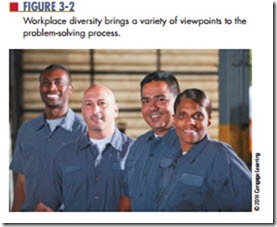Workplace Diversity
Diversity refers to creating a workplace that respects the differences of each employee, recognizes the unique contributions that a diverse workforce can make, and seeks to bring out the full potential of all employees.
Our current understanding of workplace diversity began to develop in the 1960s. A series of executive orders required federal contractors to comply with equal employment opportunity objectives.
Today, diversity in the workplace means seeking to improve job performance by embracing the cultural differences among employees.
Workplace diversity is most often associated with the following:
● Age: Older workers have experience and know time-tested practices that may not be taught elsewhere.
● Cultural Differences: Differences in thinking through upbringing and education bring about a greater variety of solutions to a problem.
● Demographics: The most basic type of workplace diversity, it comprises age, ethnicity, and gender.
● Disability: Accommodations provide a new per- spective to solving problems and creating design solutions.
● Education: Differences in educational background afford a different base of knowledge.
● Ethics: This field encompasses fundamental dif- ferences of values and objectives as well as the
function, purpose, and importance of the work to be performed.
● Ethnicity: Cultural differences bring a broader perspective to problem solving and design.
● Experience: Life experiences can result in an employee having unique ideas and different perspectives.
● Gender: Men and women often bring different ways of thinking that result in different solutions.
● Socioeconomics: This entails the combined so- ciological and economic measure of an employee’s work experience based on education, income, and occupation.
● Veterans: These people bring a work ethic and experience not provided by a purely academic edu- cation, as well as the ability to work long hours and with a diverse workforce.
● Work History: Different experiences from various employments can have a positive effect when look- ing for solutions.
Diversity can be used to bring people together to share a common experience in the workforce. Workplace diversity can also develop creative discussion and inventive solutions based on the differences in experience and knowledge that each employee brings to the team (Figure 3-2).
Creating a fully diverse workplace requires a lot of thought, effort, and action. Remember, each workplace is established through different sets of standards. Employees tend to align themselves with employees they are comfort- able with. They choose characteristics in these employees that they want to enhance in themselves. These employ- ees’ unique characteristics make the workplace stronger.
Several challenges to workplace diversity exist in almost any work environment. Working through these issues can help strengthen an employer, but ignoring them can ruin one.
Some challenges to workplace diversity are presented here:
● Communication is essential to a diverse workplace because each person and cultural group communicates differently. The wrong message can be sent through body language, e-mails, a failure to inter- act properly, or by misinterpreting tone of voice.
● Change is easier for some and more difficult for others who have different experiences. Change can be more effective when brought about slowly rather than by trying to adapt all at once.
● Management by supportive managers and super- visors is essential in supporting a diversity plan to get maximum results.
Workplace diversity challenges weigh considerably on an employer’s success. These challenges serve to improve employee relationships and to promote diver- sity when handled correctly. These challenges can help their employees to decrease workplace tension, foster a positive place to work and grow as an employee, im- prove productivity, and improve their relationships with management and fellow employees.
Management through strategic planning can create a diverse and productive workforce. Managers must couple ongoing diversity training with continuous learning opportunities for all employees. Management must work toward creating a culture of diversity that follows the vision set forth by the employer.
Questions
1. What is diversity?
2. How did diversity in the workplace come about?
3. What are five things that workplace diversity is associated with?
4. What issues are associated with workplace diversity?
5. How can diversity be promoted in the workplace?
